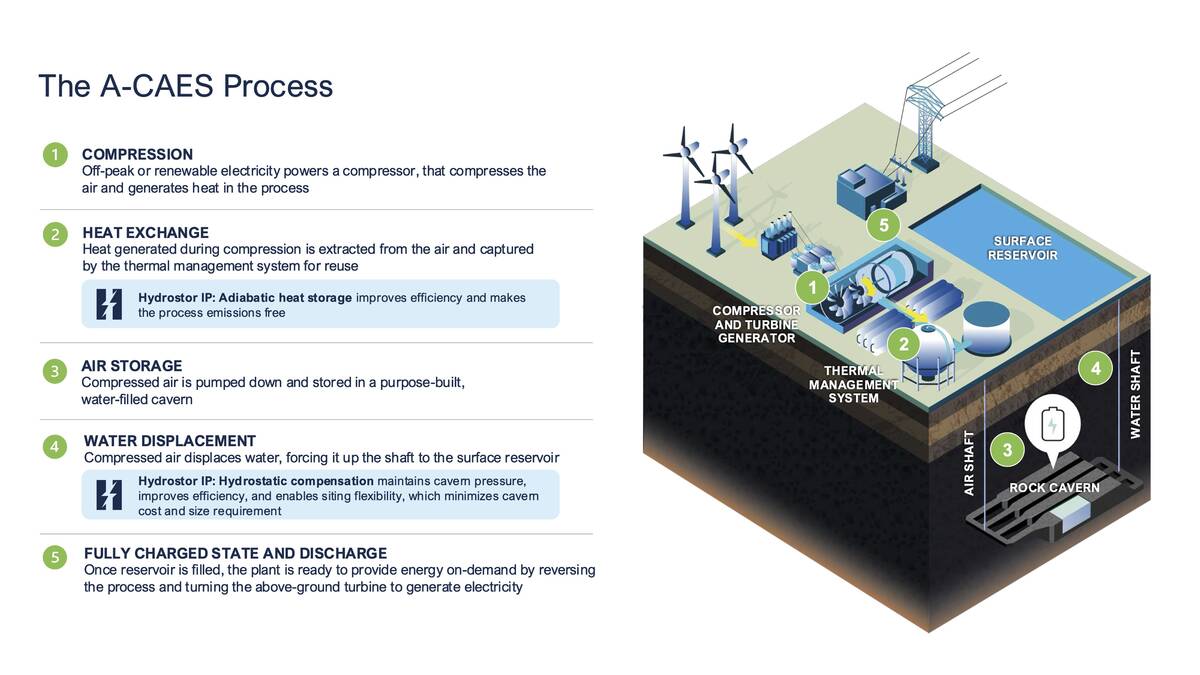
As Boulder City gets more involved in leasing land for energy production on the outskirts of town, the questions inevitably turn to excess production and energy storage.
Last year, the city council voted to approve an energy storage facility that would use large batteries to store energy. But, in June, they voted 4-1 (with Council member Matt Fox opposed) to approve the beginning stages of changing the land use plan to allow for an energy storage facility that would use no batteries. Fox was opposed due to the location, which he described as too close to areas some of his supporters use for off-highway vehicle recreation.
The proposal, by Canadian company Hydrostor, would be like nothing anyone in Boulder City has ever seen.
Let’s start with a quick review of how electricity is generated in the engineering marvel that is the very reason for the city’s existence —Hoover Dam.
The dam impedes the flow of the Colorado River, turning a former desert valley into a reservoir that is more than 1,200 feet deep when it is full.
As water continues to flow into the area, it enters the dam at near the 900-foot deep mark and becomes something like an enormous indoor waterfall. As the water falls through large pipes to the point near the bottom of the dam where it is released back to the river, it turns giant turbines. An old one of these can be seen in Wilbur Square. The turbines rotate a shaft which, in turn, rotates a series of magnets inside an enclosure of copper coils and the fluctuations in the magnetic field are converted to electricity.
Most electricity generation, including wind, uses the same kind of spinning setup with the difference being what power is used to produce the rotation. Solar is the lone exception here.
As more and more panels, which convert sunlight to electricity, are installed in a valley where the sun shines almost year-round, the point is rapidly coming when the Eldorado Valley will produce more electricity during the day than can be absorbed by the grid. The challenge becomes how to store that “excess production” so that it can be used after the sun goes down.
Dean Tuel, Hydrostor’s Vice President of Origination for North America, recently came to speak with the council to explain how the system works. In its most simple form, the technology uses excess solar energy and then the weight of water to compress and then release air in a way that drives the same kind of turbines as in Hoover Dam, except in the middle of the desert.
Hydrostor was co-founded by Curtis VanWalleghem and Cameron Lewis in 2012. Together they came up with the idea for A-CAES technology, or compressed air energy storage.
If the project ends up moving forward, Hydrostor would excavate a large cavern underground in a 300-acre parcel of desert. Above the cavern would be a reservoir as well as turbines that serve a dual purpose.
The cavern would be filled (a “one-time” fill as Tuel put it) with water. During the day, excess solar energy would be used to power the turbines in one direction to compress air and force it into the cavern. The air would be compressed to such a degree that it would force the water to the top and then out of the cavern and into the reservoir. The air compression process would create heat, which is captured and stored to be used later in the process.
At night, when the air is no longer being compressed and pumped into the cavern, the weight of the water would rush back down into the cavern, displacing the air and causing it to flow in the opposite direction, turning the turbines and generating electricity.
In short, it is not actually storing electricity in the form of electrons. It is storing the potential for electricity in the form of pressure and thermal energy potential.
“We’re hopeful that we’ll be able to bring an A-CAES facility to Boulder City, and we’re pleased to be working with the Boulder City Council and the Boulder City community to try and make that a reality,” said Hydrostor President Jon Norman. “A-CAES facilities provide numerous economic benefits to the communities where they’re located and are built on a relatively small land footprint, which are significant advantages compared to traditional energy storage projects.”
While compressed air for turning turbines has been done before, it has always required a heat source which, in turn, usually involves burning natural gas, which makes the process less than net zero in terms of carbon. But the heat capture tech used by Hydrostor negates that need.
“When power is needed from an A-CAES system, the compressed air in the underground cavern is forced back to the surface using the pressure from the water also stored in the cavern,” said Hydrostor’s director of media relations Emily Smith. “Once that air reaches the surface, it is reheated and pushed through turbines to create electricity. This is necessary because a heat source is always required when using ambient air to power a turbine. In the case of A-CAES, this heat source comes from the compressor for fuel-free operation rather than an external source like burning natural gas.”
It may sound like science fiction, but the company is already doing this in Canada. Hydrostor’s two mega-watt Goderich facility was commissioned in 2019, and is contracted to Ontario’s Independent Electricity System Operator.
The Goderich facility showcases the capabilities of the technology and provides a foundation for Hydrostor’s other projects, two of which are in late-stage development in California and Australia, and are expected to come online before the end of the decade. In addition to these two projects, Hydrostor has a global pipeline of more than seven gigawatts, which includes the proposed Boulder City project.